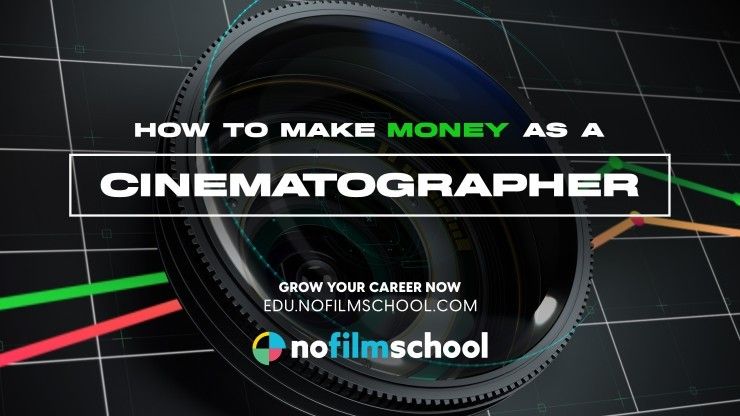
Being a working cinematographer often comes with unexpected challenges.
The following material is an excerpt from the No Film School How to Make Money as a Cinematographer course.
We all know about the creative parts of being a filmmaker, which we love—getting behind a camera, finding the most innovative shots, trying new tech, and eventually reaching the end of a project. But if you're a working cinematographer at any level, you know that there's more to it than the next hot camera or being on sets.
And most of the time, you won't be taught those things—even in film school. You'll have to figure it out the hard way. By failing.

1. How to Invoice
You've completed the work for a great client, and it's time to get paid. You're a professional, so you want your financial documents to look professional, too. Don't just scribble out a note that says, "You owe me $1,000." Professionalism aside, proper invoicing is the foundation of getting paid properly and on time. As with any business, it's important to keep track of what you are charging and when (so you can increase your rate over time). This also helps you keep things organized when it's time for tax season. But we'll get to that later.
First, you should have discussed your rates with the client before starting any work, so nothing will be a surprise (for either of you). An invoice is a document that lists all of the services performed and what they cost, with pertinent information like dates, tax information, and how and when you'd like to receive payment. Your information, like your business name, address, and logo will be the same for every client, so it makes sense that you'd create a template and copy it for each new client. While you can evolve things as time goes by, consistency is key.

There are programs that will create invoices for you, but they usually cost money, and we're all about saving you cash here.
You can use any sort of Excel-style template for your invoicing. This can be made in Microsoft Excel, Google Sheets, or Apple Numbers. You can also use Word, Pages, or Google Docs.
Include the following on your invoice:
- Your name, business name, and address
- Client details
- Invoice number (this should be unique to each invoice)
- Date issued and date due
- Section for digital payment via Paypal, CashApp, Venmo, or Zelle
- Line for an EIN or SSN
- Itemized table with:
- Date, item name, description, day rate, quantity, subtotal, and total
You should be specific in your itemized list, so the client knows exactly what they're paying for. Include things like your rate, any equipment or kit fees, and hours (or days) worked. But that's only the first step. What happens after the project wraps?
2. How to Organize Your Finances
The life of a freelancer is awesome, but being a contractor, you're responsible for a lot more when it comes to your finances. And if you don't track them, you can end up in a deep hole come tax season. No one wants trouble with the IRS. Remember when we mentioned how proper invoicing helps you stay organized?
You can, of course, keep a ledger, but since you don't work in Scrooge's office, this will probably not be on paper but in an app or program. But which one should you choose? Here are just a few options to get you started:
Several of us at No Film School have used Quickbooks for several years, but each cinematographer will have to decide which bookkeeping program works best for them.
3. How to Join a Cinematography Union
To get better work, most cinematographers in the industry make it a goal to join the union in our field. Do you have to? Not always, but that's a longer conversation for another day. A union is beneficial because you get things like employee protections, access to union projects, healthcare, and a plan for retirement. The cinematographers’ union is IATSE Local 600 and handles creatives from all around the globe.

First of all, you need to become eligible. Joining requires working in your chosen discipline for a number of days. This could be 30 days on union projects in one year, or 100 working days on non-union projects within a period of three years. In both cases, you need to work under one classification, such as an AC (camera assistant), operator, or Director of Photography, to name a few. You can read more here.
Once you're ready, you can apply to join. The union is divided by region, so you will have different requirements based on your working location. Learn about those here.
After that, you'll be placed on an Industry Experience Roster (IER) or Television Commercial Roster (TCR). You'll then be able to work on union projects, and soon after, you'll be eligible to join Local 600! However, we're glossing over a lot of important information. There's heaps of information left to learn. This is why we've developed...
The First Course From No Film School
These topics are just the beginning. As you can imagine, there is so much more detail to dive into.
How do you start and manage a client list? How do you climb the ranks? How can you buy new gear in a way that actually saves you money? What more do you need to know about union work? How about how to do your taxes?
To answer these questions, No Film School has created the How to Make Money as a Cinematographer course to teach you how to become a better creative. Not as a shooter but as a business.
This course includes 75 lessons, over 8 hours of videos, and 50+ written resources that go into detail about all of these concepts and more! We give tried-and-true examples and tools so creatives can focus on being creative instead of running their business. There's that word again. Yes, you are running a business! Many of us are not great at that, and it's what keeps us from more success.
We want to support you on this journey. We want you to make money—and find ways to save that money so you can reinvest that back into your career. This course helps you do that right away.
So check out No Film School's How to Make Money as a Cinematographer course and get some help on your journey. We can't wait to see where it takes you!

Your Comment